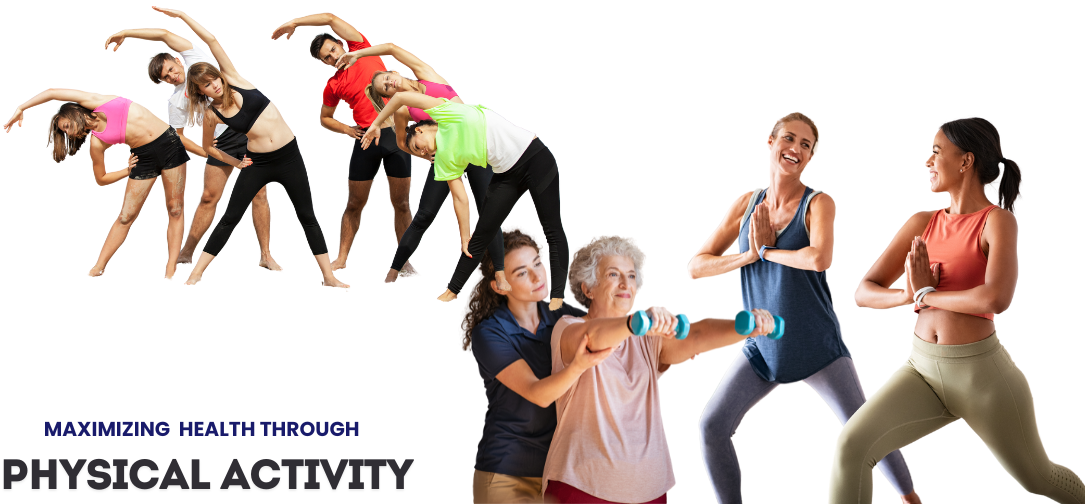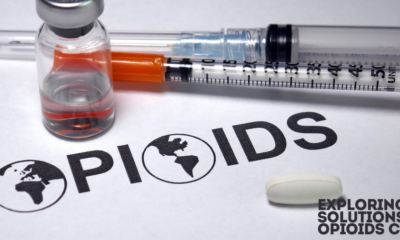Health & Fitness
Physical Activity Guidelines: How Much Exercise Do You Really Need?

Physical activity is a cornerstone of good health and well-being. Yet, the question remains: How much exercise is necessary to reap its benefits? While everyone knows that exercise is essential, determining the right amount can be challenging, as it depends on various factors such as age, gender, health status, and personal fitness goals. This article provides a comprehensive overview of the recommended physical activity guidelines, their scientific basis, and how to implement them in daily life.
Understanding Physical Activity and Its Importance
Physical activity encompasses any movement that requires energy expenditure, ranging from everyday tasks like walking and gardening to structured exercise routines such as running, swimming, or resistance training. According to the World Health Organization (WHO), physical inactivity is one of the leading risk factors for global mortality, contributing to a range of chronic conditions such as cardiovascular disease, diabetes, cancer, and obesity.
Regular physical activity offers numerous benefits, including:
Improved Cardiovascular Health: Exercise strengthens the heart, improves blood circulation, and reduces the risk of heart disease and stroke.
Weight Management: Physical activity helps control weight by burning calories and increasing metabolism.
Mental Health Benefits: Exercise reduces symptoms of depression, anxiety, and stress while boosting mood and overall mental well-being.
Enhanced Musculoskeletal Health: Regular activity helps maintain bone density, muscle strength, and joint flexibility, reducing the risk of osteoporosis and arthritis.
Prevention of Chronic Diseases: Exercise plays a crucial role in managing and preventing conditions like Type 2 diabetes, hypertension, and certain cancers.
Longevity: Studies have shown that regular physical activity can extend life expectancy by reducing the risk of premature death.
Physical Activity Guidelines Across Different Age Groups
The amount of physical activity required varies significantly across age groups, with specific recommendations tailored to children, adolescents, adults, and older adults. These guidelines are based on extensive research and aim to optimize health outcomes.
1. Children and Adolescents (Ages 5-17)
For children and adolescents, physical activity is vital for healthy growth and development. The WHO and the U.S. Centers for Disease Control and Prevention (CDC) recommend:
- At least 60 minutes of moderate to vigorous-intensity physical activity daily. This should primarily be aerobic exercise, such as running, cycling, or swimming. Aerobic activities improve cardiovascular and respiratory fitness, essential for overall health and development.
- Muscle-strengthening activities like climbing, push-ups, or gymnastics should be included at least three days per week. These activities help in building muscle strength and endurance.
- Bone-strengthening exercises, such as jumping or running, are also recommended three times a week. These exercises help improve bone density and prevent future bone-related issues.
Encouraging children to engage in diverse activities, including sports, dance, and outdoor play, is crucial to fostering a lifelong habit of staying active. Schools, parents, and communities play an essential role in promoting and facilitating an environment that supports physical activity.
2. Adults (Ages 18-64)
For adults, physical activity guidelines focus on maintaining overall health, preventing chronic diseases, and enhancing quality of life. The WHO, CDC, and American Heart Association (AHA) suggest:
- At least 150 to 300 minutes of moderate-intensity aerobic activity, such as brisk walking, cycling, or swimming, per week. Alternatively, 75 to 150 minutes of vigorous-intensity aerobic activity, such as running or high-intensity interval training (HIIT), is recommended. Combining moderate and vigorous-intensity activities is also an option.
- Muscle-strengthening activities involving major muscle groups, such as weightlifting, resistance band exercises, or body-weight exercises (push-ups, squats), should be done on two or more days per week.
- Flexibility and balance training, such as yoga, pilates, or tai chi, are recommended, particularly for enhancing mobility and preventing falls, especially as one ages.
Adults should aim to spread their physical activity throughout the week and integrate it into their daily routines. For example, walking or cycling to work, taking the stairs instead of the elevator, and incorporating physical activity into leisure time can significantly benefit overall health.
3. Older Adults (Ages 65 and Above)
Physical activity remains essential for older adults, especially as it plays a significant role in maintaining independence, mobility, and mental health. The guidelines for older adults are similar to those for younger adults, with some additional considerations:
- 150 to 300 minutes of moderate-intensity aerobic activity per week or 75 to 150 minutes of vigorous-intensity aerobic activity. However, intensity should be adjusted based on individual capabilities and health conditions.
- Muscle-strengthening activities should be done on two or more days a week. These exercises help in maintaining muscle mass and strength, which naturally decline with age.
- Balance and flexibility exercises are particularly crucial for older adults to prevent falls and maintain mobility. Activities like tai chi, yoga, or simple balance exercises (e.g., standing on one foot) are recommended at least three days a week.
For older adults with chronic conditions, physical activity should be tailored to their abilities, and they should consult healthcare professionals to ensure safety.
Types of Physical Activity: Understanding Intensity Levels
Physical activity can be categorized into three intensity levels: light, moderate, and vigorous. Understanding these levels can help individuals choose appropriate activities that align with their fitness goals and capabilities.
1. Light-Intensity Activities: These activities do not cause a significant increase in heart rate or breathing. Examples include slow walking, light stretching, or household chores. While light-intensity activities are beneficial for overall movement and flexibility, they do not count towards meeting the minimum physical activity guidelines for substantial health benefits.
2. Moderate-Intensity Activities: These activities increase heart rate and breathing but still allow one to carry on a conversation. Examples include brisk walking, dancing, gardening, or cycling at a moderate pace. Moderate-intensity activities improve cardiovascular fitness, manage weight, and prevent chronic diseases.
3. Vigorous-Intensity Activities: These activities cause a significant increase in heart rate and breathing, making it difficult to speak more than a few words without pausing for breath. Examples include running, fast cycling, high-intensity interval training (HIIT), or competitive sports. Vigorous-intensity activities provide substantial cardiovascular benefits, improve endurance, and help in weight loss.
To gauge exercise intensity, the “talk test” is often used: if you can talk but not sing during the activity, it is likely moderate-intensity. If you can say only a few words without pausing for breath, it is vigorous-intensity.
The Science Behind Physical Activity Guidelines
The physical activity guidelines are grounded in extensive scientific research that examines the relationship between physical activity, health outcomes, and longevity. Key studies that form the basis of these guidelines include:
1. Epidemiological Studies: Large-scale population studies have consistently shown a strong inverse relationship between physical activity levels and the risk of chronic diseases, such as heart disease, Type 2 diabetes, and certain cancers. Regular physical activity is associated with a reduced risk of premature death.
2. Randomized Controlled Trials (RCTs): RCTs provide high-quality evidence on the benefits of specific types and intensities of physical activity. For example, RCTs have demonstrated that aerobic exercise and resistance training significantly improve cardiovascular fitness, muscle strength, and metabolic health.
3. Dose-Response Relationship: Research indicates a dose-response relationship between physical activity and health benefits. Even small amounts of physical activity can provide health benefits, but more significant benefits are seen with increased frequency, duration, and intensity. However, there is a threshold beyond which the additional benefits plateau, underscoring the need for balance.
4. Mechanistic Studies: These studies explore how physical activity affects various biological systems, such as the cardiovascular, musculoskeletal, and endocrine systems. They help explain the underlying mechanisms through which exercise exerts its protective effects, such as improved insulin sensitivity, reduced inflammation, enhanced immune function, and better lipid profiles.
Overcoming Barriers to Physical Activity
Despite the well-documented benefits of physical activity, many people struggle to incorporate it into their daily lives. Common barriers include lack of time, motivation, access to facilities, and fear of injury. Addressing these barriers is crucial for promoting a more active society.
1. Lack of Time: Many people perceive that they do not have enough time for exercise due to work, family, and other commitments. However, physical activity can be broken down into shorter bouts throughout the day, such as three 10-minute walks or a quick 20-minute HIIT workout. Integrating activity into daily routines, like walking during breaks or cycling to work, can also help.
2. Lack of Motivation: Motivation can be a significant barrier, especially for those who do not enjoy traditional forms of exercise. Finding enjoyable activities, such as dancing, hiking, or playing sports, can help maintain motivation. Setting realistic, specific, and achievable goals and tracking progress can also enhance motivation.
3. Access to Facilities: Limited access to gyms, parks, or safe environments for exercise can hinder physical activity. Community initiatives, such as developing public parks, pedestrian-friendly infrastructure, and subsidizing gym memberships, can help address this barrier. Additionally, body-weight exercises and online workout programs can provide alternatives that require little to no equipment.
4. Fear of Injury: Some people, particularly older adults or those with chronic conditions, may fear injury during exercise. Starting with low-intensity activities, seeking professional guidance, and incorporating proper warm-ups and cool-downs can reduce the risk of injury.
Tailoring Physical Activity to Individual Needs
Physical activity is not a one-size-fits-all approach. Individual preferences, goals, health status, and abilities should be considered when designing an exercise regimen. Here are some tailored recommendations:
1.For Beginners: Start with low to moderate-intensity activities, such as brisk walking, cycling, or swimming. Gradually increase intensity and duration as fitness improves. Joining a group class or exercising with a friend can provide additional support and motivation.
2. For Weight Management: Combine aerobic exercises (e.g., running, cycling) with resistance training (e.g., weightlifting, body-weight exercises) to maximize calorie expenditure and preserve muscle mass. High-intensity interval training (HIIT) has been shown to be particularly effective for weight loss and improving cardiovascular fitness.
3. For Older Adults: Focus on low-impact activities that improve strength, balance, and flexibility, such as walking, swimming, yoga, or tai chi. Incorporate strength training exercises using resistance bands or light weights to maintain muscle mass and bone density.
4. For People with Chronic Conditions: Consult with healthcare professionals to develop a safe and effective exercise plan tailored to specific conditions. Low-impact activities, such as walking, stationary cycling, or water aerobics, are often recommended.
Conclusion
Understanding the physical activity guidelines and their underlying principles is crucial for optimizing health and well-being. Regular physical activity is a powerful tool for preventing chronic diseases, enhancing mental health, and promoting longevity. The recommended amount of physical activity varies across age groups and individual needs, emphasizing the importance of a personalized approach.
Incorporating regular physical activity into daily life requires overcoming common barriers such as lack of time, motivation, and access to facilities. With the right strategies and support, anyone can achieve the recommended levels of physical activity and enjoy its vast benefits. As the adage goes, “Exercise is medicine,” and it’s available to everyone, anytime, anywhere. So, lace up your sneakers, take that first step, and embrace a healthier, more active lifestyle today.
-

 Press Release5 days ago
Press Release5 days agoClinical Trials Market Set for Robust Growth, Driven by Drug Development Surge and Digital Innovation
-

 Press Release6 days ago
Press Release6 days agoGreen Bio Chemicals Market Poised for Sustainable Growth amidst Global Shift to Eco-Friendly Alternatives by 2035
-

 Press Release5 days ago
Press Release5 days agoFill-Finish Pharmaceutical Contract Manufacturing Market Expected to Flourish Amid Biopharmaceutical Boom and Global Outsourcing Trend by 2035
-

 Press Release5 days ago
Press Release5 days agoIndustrial Boiler Market Expected to Surpass USD 24.4 Billion by 2035 Amid Growing Demand for Energy Efficiency and Industrialization
-

 Business7 days ago
Business7 days agoHow Managed IT Solutions Help Small Teams Compete at Enterprise Scale
-

 Press Release5 days ago
Press Release5 days agoPreventive Vaccines Market to Witness Strong Growth by 2035
-

 Press Release6 days ago
Press Release6 days agoPet Food Nutraceutical Market Set for Robust Expansion Amid Rising Demand for Pet Wellness by 2035
-

 Press Release5 days ago
Press Release5 days agoWaterproof Structural Adhesives Market: A Comprehensive Study Towards USD 10.3 Billion in 2035






























